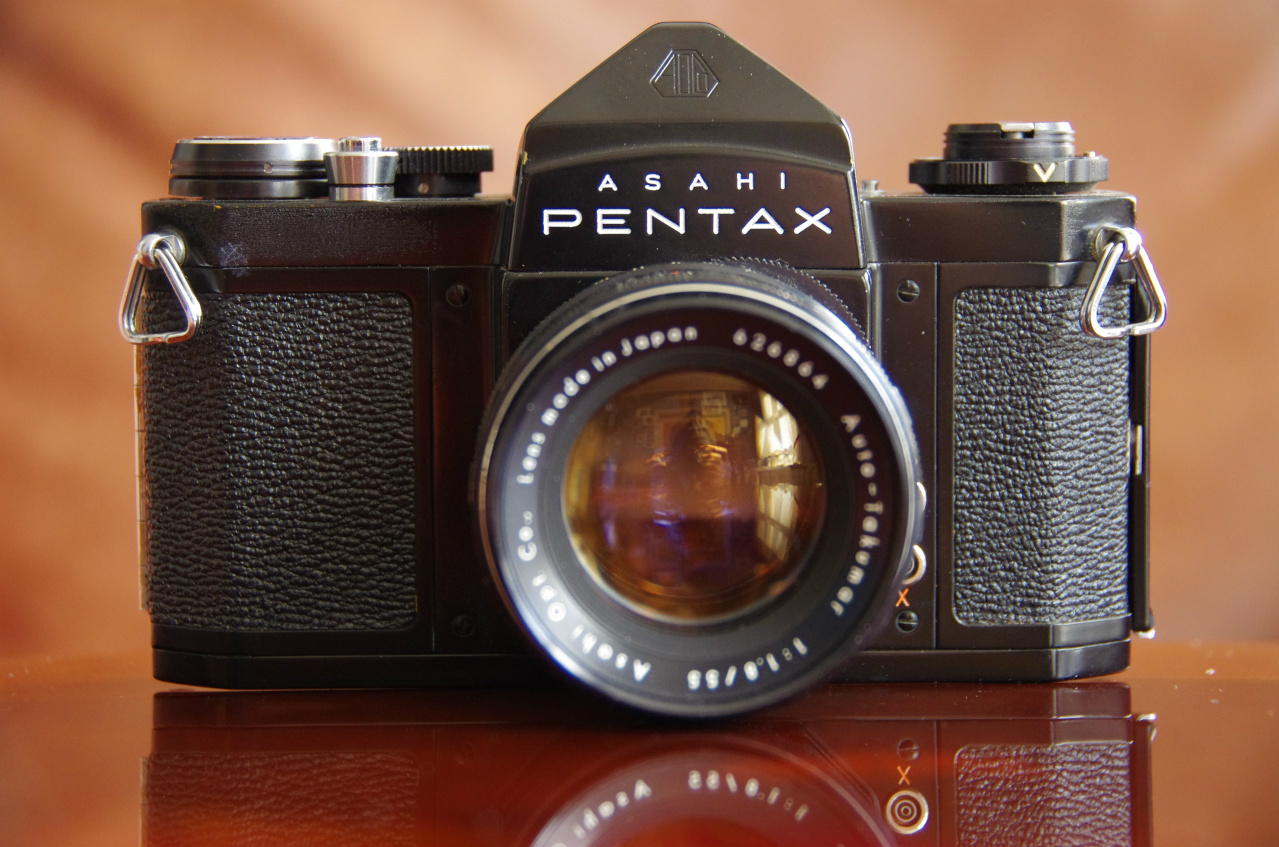Pentax Serial Number Database

Asahi Pentax S came almost a year after the original. The only significant improvement was the shutter speeds changing from 500-200-100-50-25-10-5-2-1 to the more mathematically correct 500-250-125-60-30-15-8-4-2-1, as had become more common at the time.
Besides, the inner base and right side wall was prepared for the actuator that was to come with the K model two months later. These differences is described later. Another small change was the design of ASA values on the dial around the rewind crank. The AP had ASA engraved on the top plate of the body, while the S had it written on the ASA dial. The whole range of pre-Spotmatic PP SLRs has been named the S-series.
The Pentax Forums users expended substantial effort to compile K1000 serial numbers and data to develop what I believe is a reliable table showing when K1000s were manufactured. If you have a K1000 or are curious, check it out here.
My first S model camera has sn. Size: 145x92x50mm. Weight: 580 g. Asahi Pentax S came almost a year after the original. The only significant improvement was the shutter speeds changing from 500-200-100-50-25-10-5-2-1 to the more mathematically correct 500-250-125-60-30-15-8-4-2-1, as had become more common at the time. Besides, the inner base and right side wall was prepared for the actuator that was to come with the K model two months later. These differences is described later.
Another small change was the design of ASA values on the dial around the rewind crank. The AP had ASA engraved on the top plate of the body, while the S had it written on the ASA dial. The whole range of pre-Spotmatic PP SLRs has been named the S-series.
My first S model camera has sn. Size: 145x92x50mm. Weight: 580 g. Asahi Pentax K, some sources say for King, others say Kilo (1000, referring to the shutter speed) was released less than two months after the S, and was Asahis first with a shutter speed of 1/1000 sec.
But more important was the new set of lenses that came with it, the Auto-Takumars, giving you a semiautomatic diaphragm. When pushing the trigger,the aperture of the lenses were set by a pin that was pressed by a moving part, an actuator, just inside the mount of the camera. Size: 145x92x50 mm.
Weight: 586 g. Asahi Pentax K, some sources say for King, others say Kilo (1000, referring to the shutter speed) was released less than two months after the S, and was Asahis first with a shutter speed of 1/1000 sec. But more important was the new set of lenses that came with it, the Auto-Takumars, giving you a semiautomatic diaphragm. When pushing the trigger,the aperture of the lenses were set by a pin that was pressed by a moving part, an actuator, just inside the mount of the camera. Size: 145x92x50 mm. Weight: 586 g. Asahi Optical had really shown the way forward for the camera industry with their first three PP SLRs from 1957 till 1958.
Already in 1959 they continued their S series with the S2. The whole series was a continuing development, sometimes with different versions of the same model, other times introducing new models.
There were at least two versions of the S2, the later one with a notch in the shutter time dial to fit the new light meter introduced in 1960. In addition to this, the S2 had different names for different markets. The Asahi Pentax S2 for Japan and general international market, Asahi Pentax H2 sold in several markets, Honeywell Heiland Pentax H2 sold in the US, later branded Honeywell Pentax H2, Asahi Pentax SB, B instead of 2, being the second letter in the alphabet,sold only in Japanese military camps, (from 1961 also the very rare SB2, a special version of the S3) and Asahiflex H2 sold in South Africa, possibly also in Finland. However, although not mentioned in literature, there was even an Asahi Pentar H2 AND a Penta Asahiflex H2 produced for the South African market, maybe also sold elsewhere. Another rare sample, the Asahiflex H2.
As Pentacon owned the rights to the name Pentax in some small markets, only South Africa is known*, Pentax had to sell their cameras under another brand name until they had come to an agreement with Pentacon of East Germany. The AP was not exported there, but the S and K (and some early H2s!!) were sold as Pentar, later as Penta Asahiflex, while most H2s were sold as Asahiflex, like this sample with sn: 288028. Lens on this one was a Auto-Takumar 55/2,2, sn. 620816, probably not delivered with the camera originally, as standard lens for S2/H2 was 55/2.
*According to a manual following S2 from 1959, the same regulations covered Finland, too. This is, however, not sited elsewhere in elder literature. But if so, did it stop there?
Something to dig into. Another rare sample, the Asahiflex H2. As Pentacon owned the rights to the name Pentax in some small markets, only South Africa is known*, Pentax had to sell their cameras under another brand name until they had come to an agreement with Pentacon of East Germany. The AP was not exported there, but the S and K (and some early H2s!!) were sold as Pentar, later as Penta Asahiflex, while most H2s were sold as Asahiflex, like this sample with sn: 288028. Lens on this one was a Auto-Takumar 55/2,2, sn.